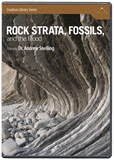
Completeness of the Fossil Record
If the Bible’s account of the Flood is true (and it is), then creationists predict that we have a nearly complete record of all species that ever lived. Recent scientific findings support that prediction.
So far, scientists have named more than 1.3 million species of living animals, and they have named only about 250,000 in the fossil record. But how many other species existed in the past without leaving any fossil remains? Have we found only a small fraction of all the species that ever walked the earth, or do we have a fairly complete record of every species that ever existed?
Since we weren’t eyewitnesses of every species that ever lived and because the Bible doesn’t directly answer this question, we will never be certain of the complete answer. But God has given us some valuable clues in the Bible and in the fossil record.
It turns out that our best guesses depend on our beliefs about earth history. Depending on our starting assumptions, we can draw very different conclusions. Let’s look at three assumptions and what they would predict about the completeness of the fossil record:
- The rock layers were deposited separately over millions of years.
- Species evolved from a common ancestor over millions of years.
- The Bible’s account of creation about six thousand years ago, followed by a global Flood.1
The Conventional Prediction: 2% of Species Preserved
The logic of those who hold the conventional “old age” view would predict that only a small percentage of species has been preserved in the fossil record. Below are the steps in their logic.
First, based on their interpretation of radioisotope dating of fossil-bearing rocks, they believe that animals have existed for the last 600 million “radiometric years.”2
On average, individual animal species appear in only a few layers of the fossil record (covering about 30 million “radiometric years”), and then they disappear. So, according to this way of thinking, all the animal species on earth must have been completely replaced 20 times. (Divide 600 million years total by 30 million years per species group = 20 species groups).
This view would also expect that the number of species alive at any other time was, on average, much less than the 1.3 million alive today—probably around 650,000.3
So by this old-age-based logic, the total number of animal species that have existed in all of earth history is roughly 13 million (650,000 x 20).4 That means only 10% of the species ever to appear on earth still have a living representative, and around 90% are extinct.
Since we have named only about 250,000 fossil species, this line of reasoning predicts that the fossil record has preserved less than 2% of all the species that have ever lived. Different assumptions yield different results, but all estimates agree that if the earth is millions of years old, very, very few of the species of the past have been preserved as fossils.
The Evolutionary Prediction
The evolutionary view leads to similar expectations but for a different reason. This view expects that a vast number of species must have formed in the past to arrive at the variety of species we see today.
Charles Darwin himself recognized that the fossil record did not contain anything like the myriad of transitional species expected in his theory. He suggested that the rarity of transitional species was because the fossil record was poor—that it preserved at the very most only a few percent of the species that lived in the past.
The Biblical Prediction: Nearly 100% of Species Preserved
A biblical perspective leads to quite different expectations. Since God ended His creation at the end of the Creation Week, we would conclude that no new animal kinds have arisen since then. On the contrary, the fact that most living species can interbreed with most other species in the same family suggests that they belong to the same biblical “kind.” Based on what we observe today, however, new species can arise within the original kinds.
The question is: when did new species arise and how many? To find the answer, we have to consider three periods of history: Creation Week, the period leading up to the Flood, and the post-Flood.
We can consider the first two periods together because almost all pre-Flood species—whether they appeared during Creation Week or some time afterward—would still be represented at the time of the Flood. (We don’t have much reason to expect that many species went extinct before the Flood.5)
Since Flood conditions were probably excellent for preserving fossils, a creationist might then expect that nearly all animal species that ever existed before the Flood were preserved as fossils in the Flood.
Yet of the land animals, only representatives of each kind were taken onto the Ark. The catastrophic nature of the Flood would have extinguished all the other species within each “kind” and probably most water-dwelling species as well. This would mean that a vast percentage of the animal species living today actually arose following the Flood.
In other words, there has been only one replacement of animal species in earth history, not twenty. Based on the ash and other materials found with post-Flood fossils, many creation scientists believe that supervolcanoes and other catastrophes in the tumultuous centuries immediately following the Flood preserved a good percentage of all the species that ever arose after the Flood.
So creationists, using this line of reasoning, expect that we have a nearly complete record of all species that ever lived, whether preserved as fossils or still breathing today.
Which Prediction Is Supported by Scientific Data?
So, do we have any way to test these two predictions? Has the fossil record preserved most of the species of the past, as expected by young-age creationists, or has the fossil record preserved a very small percentage of past species, as expected by those who believe the earth is old?
One way to determine how good the fossil record is at preserving species is simply to count how many living species are also known as fossils, regardless of whether the fossils were made before, during, or after the Flood. At least two studies have done that. In one study Björn Kurtén determined that 88% of the mammal species living in Europe today are also present in the fossil record in Europe, and 99% are present in the fossil record somewhere on earth.6
In another study, James W. Valentine, in his PhD dissertation, found that 76.8% of the marine mollusk species currently living along the southern California and Baja California coast are also found in the fossil record.7
These studies suggest that the fossil record is good at preserving past species—much closer to the expectations of young-age creationists than the expectations of those who believe that the earth is old.
Answers Magazine
January – March 2010
Fossils are filled with mystery. They are commonly used to attack the biblical worldview, but in reality the Bible gives us the keys to help us solve these mysteries. How could recently discovered dinosaur tissue have survived until today? Why is the first fossil layer filled with such an astonishing variety of life (“the Cambrian Explosion”)? Read this issue to understand these and other mysteries of our world!
Browse Issue SubscribeFootnotes
- The conventional old-earth view is that the rock layers were laid down at the same slow rate in the past as they are today. So each layer preserves fossils from different periods of history. This idea, also called uniformitarianism, predates Charles Darwin by several decades. The church’s compromise in accepting this unbiblical view of history helped set the stage for widespread acceptance of Darwin’s proposals about biological evolution over eons of time. I distinguish between the old-age view, based on geology, and the evolutionary view, based on biology, because many people today, including Christians, embrace the old-age view but reject biological evolution. Yet neither view accepts God’s Word as their starting point, and both should be evaluated against a Bible-based interpretation of the fossil record.
- The general science behind radioisotope dating is sound, but mistaken assumptions lead to exaggerated dates. See Snelling’s “Radiometric Dating: Making Sense of the Patterns,” p. 72. Based on the Bible’s revelation that earth history covers only about 6,000 years, the relative dates for rocks must refer to hours, weeks, years, or centuries, not millions of years.
- They reach this conclusion because most fossil layers have, on average, only half the number of animal groups (families or genera or species) that are found in the very top “modern” layers. This means that, if each layer contains a record of the world’s species at one time, then the average number of species at every other time in history was about half of what we find today.
- These estimates are based on the nine animal phyla that have hard parts (skeletons, shells, protective capsules). They make up most of the fossil record and also about 90% of animal species in the present.
- The Bible does not directly say if God made only one species within each “kind” during Creation Week. Were there many varieties (species) within each kind at the very beginning, or did various species arise in the years following creation? Since the Bible does reveal that God commanded the sea creatures and birds of every kind to reproduce and multiply (Genesis 1:22), it seems likely that all the species appeared somewhere on the earth at the beginning, and the animals multiplied within those species. (God didn’t necessarily create just one pair of animals within each kind.) If so, most of the species at the time of the Flood may have been the same species that God created in the beginning.
- B. Kurtén, Pleistocene Mammals of Europe (Chicago: Aldine, 1968).
- J. W. Valentine, “How Good Was the Fossil Record? Clues from the California Pleistocene,” Paleobiology 15 no. 2 (1989): 83–94.
Recommended Resources

Answers in Genesis is an apologetics ministry, dedicated to helping Christians defend their faith and proclaim the good news of Jesus Christ.
- Customer Service 800.778.3390
- © 2024 Answers in Genesis





